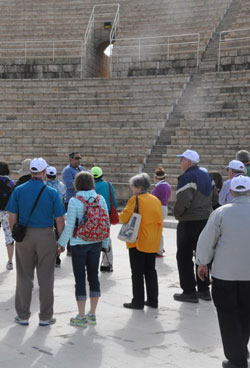By Natalie Hoefer
See a photo gallery from their day)
The day began in Caesarea, a Roman city on the Mediterranean Sea founded by Herod shortly before the birth of Christ. Here, St. Paul was imprisoned for two years. And here, a few centuries later, Christians persecuted by the Romans were fed to lions in the hippodrome included in the ancient city complex.
In the midst of the impressive 2,000-year-old architectural remains and engineering feats of the Romans, pilgrim Katherine Krapf, a member of St. Mary Parish in Indianapolis, put the site’s significance in proper order: “To think we’re walking where the blood of Christians was spilled,” she said.
Nine centuries before Caesarea was built, blood was also spilled. As the story is relayed in 1 Kings chapter 18, pagan religions practicing child sacrifice had taken hold in Israel. The prophet Elijah won a sacrificial showdown of sorts, proving his God to be the one true God.
The showdown took place on Mt. Carmel, which is actually a 25-mile range of mountains rather than a single peak. High on a southern peak of the range overlooking the Valley of Armageddon, a Carmelite monastery now stands near what is believed to be the site where Elijah challenged the pagan prophets.
“The view was unreal in every direction,” said Mary Klusas of SS. Francis and Clare Parish in Greenwood.
With the valley sprawling far behind her, Domoni Rouse smiled for a photo with Archbishop Joseph W. Tobin. It was, after all, her 64th birthday.
“To walk in Jesus’ steps on your birthday, to be in the Holy Land on your birthday—it can’t get any better than this!” said the member of St. Rita Parish in Indianapolis.
She found the Carmelite monastery and its view to be “amazing.”
“It’s something to travel and see things you only see on TV,” she commented. “But when you travel and see things like this and it’s in your spirit, too, there’s no comparison. It’s such a wonderful feeling.”
Rouse was one of many pilgrims who purchased a scapular at the monastery atop the mount for which the order takes its name.
The Carmelite order is known for wearing the scapular, two pieces of cloth bearing religious images and worn around the neck. At the Carmelite monastery, pilgrims had the opportunity to purchase scapulars which Archbishop Tobin blessed then in a special ceremony.
“The tradition [of wearing the scapular] began when the people who couldn’t live like monks and nuns [began also wearing the scapular] to find holiness, … trying in the circumstances of their own lives to live the values that motivated these women and men to leave all and follow Christ,” he explained during the short service.
“My own founder, St. Alphonsus [Liguori], said that God wants all people to be saints, but each in their own vocation. We find holiness in our own vocation. The scapular is a way of us showing solidarity with people who are pursuing holiness in [a religious] vocation.”
From the monastery, the pilgrims traveled north to Haifa where the northern slopes of Mount Carmel meet the Mediterranean Sea. Here lies another Carmelite monastery and minor basilica called Stella Maris—“The Star of the Sea.” The basilica includes an enshrined cave that is believed to have been habituated at one time by Elijah.
During his homily in a chapel at Stella Maris, Archbishop Tobin spoke of the importance of quiet in the life of a Christian.
“To be a human being, truly human, means to be able to be quiet—without falling asleep,” the archbishop said. “When I think of Elijah on this mountain, when he’s standing in that cave and he’s told to go out and meet God, … God is in the whispering sound (1 Kings 19:11-13). ...
“I think maybe what we can consider on this moment in our pilgrimage is how important it is to have that quiet time … [and] in that quietness, look for God, and listen for that whispering sound.
“Without quiet, life can become a little like trying to read a newspaper right from the end of your nose—you might be able to make out a word or a letter, but it doesn’t make sense. In quiet we can step back a little bit and let God help us see the whole picture. And in that picture we find the one who can claim our hearts, and that’s the living God.”
See a photo gallery from Day Three of the pilgrimage

No comments:
Post a Comment